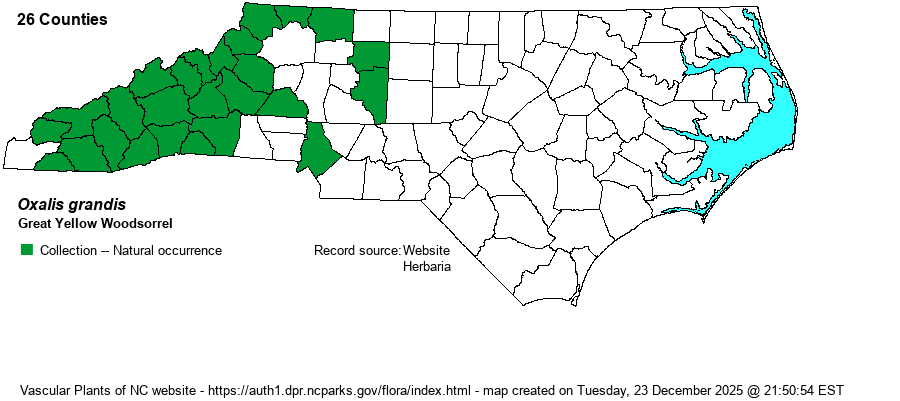| Author | Small | |
| Distribution | Throughout the Mountains, but only widely scattered into the western and nearly the central Piedmont, east to Forsyth, Davidson, and Mecklenburg counties.
This is an Appalachian and Mideastern species, ranging from PA and IN south to GA and MS. | |
| Abundance | Frequent to common in the Mountains; uncommon in the Piedmont foothills, but very rare farther eastward. | |
| Habitat | This is a species of rich hardwood forests, most often found in Rich Cove Forests. It also occurs in rocky forests, but usually where moist to rich, as the species favors circumneutral soils. |
| Phenology | Blooms in May and June, and fruits shortly after flowering. | |
| Identification | The many species of yellow-flowered Oxalis are quite similar to each other, with small details separating most. All are small, branched, with numerous 3-parted, clover-like leaves on long petioles, and inflorescences of bright yellow, 5-petaled flowers. This species, O. colorea, and O. macrantha are the only yellow-flowered species with large flowers, about 1.5 inches across; others are only 3/4-1-inch across. There is usually a faint to somewhat moderate red streak at the base of each corolla lobe, whereas the extremely rare (in NC) O. macrantha usually has a bright or strong red stripe. This is a showy wildflower of our cove forests, though there are many other species in other genera, such as trilliums, that "outcompete" it for the observer's attention in the spring. | |
| Taxonomic Comments | None (rare for an Oxalis species in NC!)
| |
| Other Common Name(s) | Large Yellow Woodsorrel | |
| State Rank | S3? [S4] | |
| Global Rank | G4G5 | |
| State Status | | |
| US Status | | |
| USACE-agcp | | |
| USACE-emp | | |

